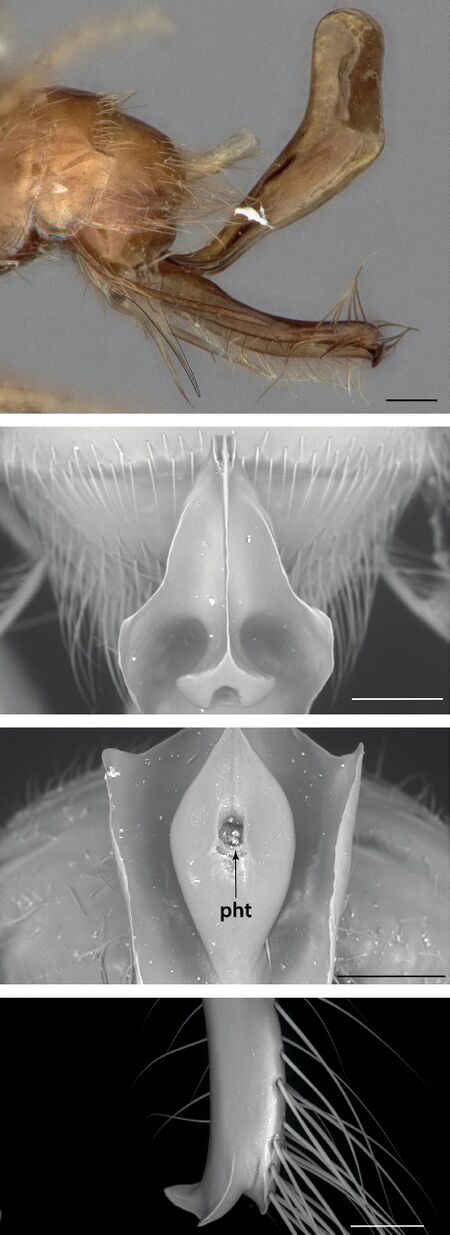Leptanilla najaphalla
| Leptanilla najaphalla | |
|---|---|
| Scientific classification | |
| Kingdom: | Animalia |
| Phylum: | Arthropoda |
| Class: | Insecta |
| Order: | Hymenoptera |
| Family: | Formicidae |
| Subfamily: | Leptanillinae |
| Tribe: | Leptanillini |
| Genus: | Leptanilla |
| Species: | L. najaphalla |
| Binomial name | |
| Leptanilla najaphalla Griebenow, 2024 | |
 Griebenow (2024), Figure 14. Male genitalia of Leptanilla najaphalla. A, profile view, apicolateral gonocoxital lamina outlined (CASENT0106424). B, penial apex, posteroventral view (CASENT0106421). C, penial sclerites and phallotreme, ventral view (CASENT0106433). D, volsellar apex, dorsal view (CASENT0106421). Abbreviation: pht = phallotreme. Scale bars: 0.1 mm (A, C, D); 0.2 mm (B).
Griebenow (2024), Figure 14. Male genitalia of Leptanilla najaphalla. A, profile view, apicolateral gonocoxital lamina outlined (CASENT0106424). B, penial apex, posteroventral view (CASENT0106421). C, penial sclerites and phallotreme, ventral view (CASENT0106433). D, volsellar apex, dorsal view (CASENT0106421). Abbreviation: pht = phallotreme. Scale bars: 0.1 mm (A, C, D); 0.2 mm (B).
Identification
The males of L. najaphalla uniformly differ from the sympatric undescribed morphospecies Leptanilla zhg-my05, to which L. najaphalla is sister, in the outline of the apicolateral gonocoxital lamina and the proportions of the penial sclerites and volsellae to the gonocoxites.
Keys including this Species
Distribution
Latitudinal Distribution Pattern
Latitudinal Range: 4.9° to 4.9°.
| North Temperate |
North Subtropical |
Tropical | South Subtropical |
South Temperate |
- Source: Griebenow, 2024
Distribution based on Regional Taxon Lists
Indo-Australian Region: Malaysia (type locality).
Distribution based on AntMaps
Distribution based on AntWeb specimens
Check data from AntWeb
Countries Occupied
| Number of countries occupied by this species based on AntWiki Regional Taxon Lists. In general, fewer countries occupied indicates a narrower range, while more countries indicates a more widespread species. |

|
Estimated Abundance
| Relative abundance based on number of AntMaps records per species (this species within the purple bar). Fewer records (to the left) indicates a less abundant/encountered species while more records (to the right) indicates more abundant/encountered species. |

|
Biology
Castes
Nomenclature
The following information is derived from Barry Bolton's Online Catalogue of the Ants of the World.
- najaphalla. Leptanilla najaphalla Griebenow, 2024: 106, figs. 13-16 (m.) MALAYSIA (Sabah).
Type Material
- Holotype. Malaysia – Sabah • 1 male; Sipitang Dist., Mendolong; 4.917°N, 115.767°E (estimated from Google Earth to nearest minute); 27 Apr. 1988; S. Adebratt leg.; A1L; CASENT0106427 (MZLU00174197); MZLU.
- Paratypes. 5 male; same locality as for preceding; 16 Apr. 1988; S. Adebratt leg.; A1L; CASENT0106416 (MZLU00174186), CASENT0106417 (MZLU00174187), CASENT0106438 (MZLU00174208), CASENT0106444 (MZLU00174214), CASENT0106457 (MZLU00174227); MZLU • 5 male; same locality as for preceding; 19 Apr. 1988; S. Adebratt leg.; W5L; CASENT0106421, CASENT0106432, CASENT0106433, CASENT0106449, CASENT0106450; UCDC • 2 male; same locality as for preceding; 7 Apr. 1988; S. Adebratt leg.; A1L; CASENT0106435 (MZLU00174205), CASENT0106437 (MZLU00174207); MZLU • 1 male; same locality as for preceding; 4 May 1988; S. Adebratt leg.; T4/R; CASENT0106412; MCZC • 2 male; same locality as for preceding; 5 May 1988; S. Adebratt leg.; A1L; CASENT0106418, CASENT0106453; MCZC • 3 male; MALAYSIA, Sabah: same locality as for preceding; 13 May 1988; T4/R; CASENT0106414, CASENT0106415, CASENT0106429; CAS.
Taxonomic Notes
The description of L. najaphalla only from male specimens is justified for the same reasons as provided for the description of Leptanilla bethyloides, also only from male specimens: the clade to which this species belongs, heretofore referred to as the “Bornean morphospecies group”, is known only from male specimens. Leptanilla najaphalla was included in the phylogenetic analyses of Griebenow (2020, 2021) under the provisional identifier Leptanilla zhg-my02, with the genitalia being the subject of detailed morphological study using micro-computed tomography (Griebenow et al. in press) under that same provisional identifier.


